Nikon D300 Review
Review Date: January 21st 2008
Author: Gavin Stoker
Leave a comment about this Review
|
Introduction
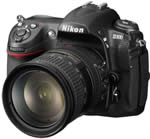
The Nikon D300 is the successor to the hugely popular D200 DSLR camera, and Nikon certainly haven't rested on their laurels, adding a veritable wealth of features to their new mid-range model. Aimed at the pro photographer on a budget, or the keen amateur with money to invest, the D300 is a 12.3 megapixel digital SLR with next-generation 51-point AutoFocus system, effective ISO range of 100-6400, continuous shooting mode of 6fps and 3 inch, 920,000 pixel LCD screen. You can compose images on the LCD via Live View mode, and the Nikon D300's magnesium alloy body is now both water and dust resistant. The brand new EXPEED image processing engine and Advanced Scene Recognition System promise to deliver better image quality than ever before. The D300 shares many of the same features as the new pro-level D3, the main difference being the D300's APS-C / DX-format sensor (the D3 is full-frame). Gavin Stoker took the Nikon D300 for a test drive to find out if you really can get pro-level quality for £1299.99 / $1,799.95.
Compare Prices
Support PhotographyBLOG: Buy the Nikon D300 from one of our affiliate retailers:Ease of Use
The 12 megapixel CMOS sensor-sporting, DX format Nikon D300 is, at the time of writing, Nikon's latest semi professional offering, upgrading the previously acclaimed D200 and slotting into the middle of the company's DSLR line up. As you would expect at this level – and for a body-only price around £1300 – the build is tank-like and rugged, sealed against dust and droplets (with built-in sensor cleaning also) and larger in dimension than the likes of the Canon EOS 40D, Panasonic L10 or Sony A700. It's also brick-like in weight, a near match for the back-crippling E-3, particularly with the 17-55mm 1:2.8 G ED DX zoom optic Nikon provided for our test attached. Though with no image stabilisation system built into the body, opting for a VR lens would be a better bet. Given all of the above, could the Nikon D300 shape up as the perfect workhorse digital SLR for pros on a budget or, alternatively, enthusiasts who have the bank manager in a stranglehold?
Unlike lower-priced devices, chunky physical dimensions have allowed the installation of not one but two LCDs – a large main, high-resolution (920k pixels) 3-inch monitor ranged to the left of the camera back, plus a useful second display window/control panel up top for adjusting key shooting selections on the fly. The D300's heft has also facilitated a less cluttered layout than some of the most recent competition. There's no single mode wheel that tries to cram on every available shooting option but rather a dedicated mode button that, when pressed in conjunction with a twist of the command dial (of which there are two, the main one forward of the shutter button, the other sub command dial just below the status display window at the rear) allows you to scroll through the regular P, A, S, M options.
Flick the on/off dial that encircles the main shutter button and the camera powers up for action in under a second – the official speed quoted by Nikon is 0.13/sec, which basically translates as fast'. Any shutter lag is imperceptible – again the official figure is 45 milliseconds – with frame advance up to 6fps (up from the D200's 5fps), or up to 8fps with an optional multi power battery pack. The ability to rattle off a succession of images is down in part to Nikon's new on-board 'Expeed' processor, as found in the new 9fps full-frame D3 (which also ups this to 11fps in DX crop mode). Also shared between the two DSLRs is a whopping 51-point AF system, making the D300 itself one of the D3's closest challengers. Given that, perhaps the £1300 body-only price doesn't seem so daunting anymore. Whereas large, high-resolution JPEGs are committed to memory in an instant, TIFF files are almost as swift, while there's a wait of just a second or so between Raw images in single capture mode.
While the majority of controls fall readily to hand, there's also a sufficiently rounded and chunky grip to enable a good grasp, plus plenty of room for your thumb to rest without inadvertently hitting controls at the rear. This is despite the fact that Nikon has packed a lot onto the Nikon D300's outer casing. So let's take a tour of what's on offer and examine its handling. The front, or business end of the camera, appears deceptively clean of controls at first glance, but yes, there are plenty. For starters, to the right of the lens, as viewed straight on, and hugging the curve of the lower bracket for the built-in flash, are a couple of small buttons. While the top one logically activates the pop up flash, which springs satisfyingly to attention with a dull clunk, the lower one – when used in conjunction with the main command dial – provides access to the various flash modes and, with a twist of the sub command dial, the ability to adjust its strength from 3EV to +1EV.
| Top Controls | Rear Controls |
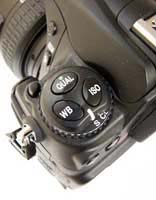 |
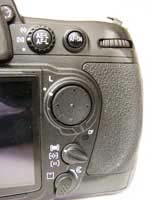 |
To the right of this is a hinged rubber flap covering a flash sync terminal and beneath this a ten pin remote port, again covered by a rubber flap. The fact that the flaps are tethered to the body at least means you don't lose otherwise lose a fiddly screw pin cover – as typically found protecting said port – down the back of the sofa. Beneath this pair of flaps, and hugging close to the lens mount, is a large-ish and prominent lens release button with a nicely springy action. Underneath again is a reasonably rigid lever for flicking between the three focus mode settings: single servo AF (as usual, the camera focusing when shutter button is depressed halfway), continuous servo AF (with the camera engaging predictive focus tracking if the subject moves, with the default result that the shutter can occasionally be released even if the subject isn't in focus), and finally manual focus.
The opposite side of the lens reveals an Fn' function button, for choosing the number of images in a bracketed sequence for example, or to otherwise lock down the chosen flash intensity, the button falling just within reach of your middle finger when your forefinger is hovering over the shutter button. Immediately above this is a second unmarked button of equal size for previewing depth of field, and, topping the pair a lamp window for all of the following: the AF assist, self timer plus red-eye reduction. Adjacent to this, on the forward slope of the grip that houses the supplied lithium ion battery at its base, is the aforementioned sub command dial, and, continuing up the slope, the shutter release button – the latter handily encircled by the on/off switch. Flanking this – and toward the back of the slope – we find the mode button mentioned earlier and an equally readily identifiable exposure compensation button. Interestingly, if you hold this button down in conjunction with the quality button on the other side of the camera top – both are marked with a green dot – the Nikon D300 is reset to its default settings (handy when the model you're playing with has been through a few sets of reviewers' hands).
Behind these we find the status display/control panel, which, when compared to some, is almost Olympic swimming pool-like in its opulence. Not only do you have plethora of operational detail and functionality displayed when in use, you also get the benefit of the number of shots remaining on the card in your selected capture format displayed even when the camera is otherwise switched off. It might have been handy though to have had some form of illuminating this display for easier reference though when shooting in lower light conditions. Still on the camera top, and next to the LCD, is the hump for the built-in flash with accessory shoe sitting on top for supplementary illumination, leading us onto a dial that contains a cat-like paw-print of three buttons for selecting ISO, image quality and white balance. Again these are used in conjunction with a twist of the command dial and reference to the top-mounted control panel.
With a twist of the dial itself – which has its own individual lock button – users can further select from single frame capture, continuous low speed capture (with the ability to customize frame rate between 1 and 6 fps), continuous high speed (up to 6fps as detailed earlier, though this can be extended to 8fps via the optional MB-D10 battery pack), Live View – rather hidden away on this model, like something of an afterthought – self timer or mirror up, to minimize camera shake. Live View is continuous – a live image activated on screen, once the mode is selected, by pressing the shutter – the screen blanking out momentarily as you take the shot. A press of the menu button brings you back out of the mode. A high resolution LCD undoubtedly helps validate this feature, though some may grumble that the screen is hampered by being fixed rather than the tilt and swivel variety, as on Olympus's new E-3 or Panasonic's L10.
| Memory Card Slot | Battery Compartment |
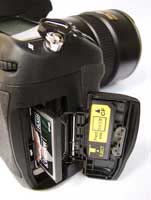 |
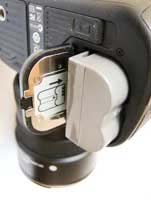 |
Moving around to the back of the Nikon D300, dominated by that main LCD screen, we find a smattering of familiar controls. Starting on the left hand flank, and running in a strip from top to bottom are, firstly, a pairing of self-explanatory controls for image playback and deletion. Secondly, below this is an equally obvious menu button, a button for protecting images from accidental deletion, a thumbnail playback/zoom out button, a zoom-in button for checking the fidelity of images post capture, and an OK button for effecting setting changes. All pretty much what you'd expect to find, and just as responsive as you'd like on this level of DSLR. Centred above the LCD monitor is the viewfinder, with a comfortable – and removable, should you want to attach viewfinder accessories at any stage – rubber eyepiece, the viewfinder itself offering 100% field of view. It's large, bright and clear, so no complaints there either. For spectacle wearers, top right of the viewfinder is a diopter dial for adjusting the focus of the viewfinder.
To the right of this again is a further dial. The outer ring is for selection from a trio of metering modes, the button at its centre for auto exposure lock and auto focus lock. Next to this is the curious AF-on button, which has the same effect as depressing the shutter release button halfway. Thankfully each of these controls is large and robust enough to avoid any unnecessary fiddling around in the heat of the action. Below this again, you get a nicely tactile multi controller for tabbing through and selecting on-screen menu options – incidentally very logically laid out and clear – encircled by the focus selector lock. With choice of 51 focus points, the camera's point of focus can be selected manually so that your intended subject is sharp wherever it is in the frame, and then of course the focus locked off.
Continuing on the same theme, beneath this we have the AF area mode selector, a switch presenting three options to the user: single point AF (for relatively static compositions), dynamic area AF (if the subject moves, the camera will adjust based on information from surrounding points) and auto area AF (the camera automatically detecting the subject and selecting the focus point). Again, the mode you've selected is indicated in the control panel window atop the camera. The final control on the Nikon D300's back, just below this, is a lever for opening the single-slot CompactFlash compartment, which flicks open instantly at the right hand side of the unit.
The left hand side of the camera – if still viewed from the back – features a large rubber cover for its more numerous than usual array of ports. Starting at the top you have video out, followed by, more unusually, an HDMI port for connecting the camera up to a high definition telly, then the standard DC in plus USB connections. The base of the camera features a screw thread for a tripod, plus the compartment for the chunky supplied EN-EL3e lithium ion battery. Battery life seems also good – I was using the Nikon D300 over a period of a couple of weeks and still had juice left over to play with.
But what of the Nikon D300's images? Has Nikon over-egged the features at the expense of the results, or does it deliver pictures that match its level of sophistication? Let's find out…
|
![]() PhotographyBLOG
is a member of the DIWA
organisation. Our test results for the Nikon D300 have been
submitted to DIWA
for comparison with test results for different samples of
the same camera model supplied by other DIWA
member sites.
PhotographyBLOG
is a member of the DIWA
organisation. Our test results for the Nikon D300 have been
submitted to DIWA
for comparison with test results for different samples of
the same camera model supplied by other DIWA
member sites.
